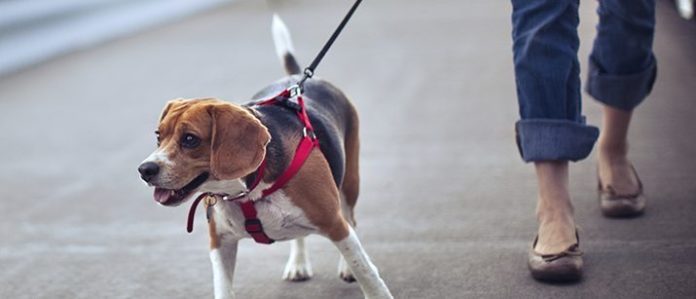As a vet, I often get asked about dogs who have suddenly started lunging at other dogs (or humans) while out on their walks. These are some tips to manage this behavior.
The lunging is often worse when the dog is on a leash, but doesn’t occur during off-leash time. It can actually be a little embarrassing when your usually calm, sociable dog all of a sudden starts lunging, barking and snapping at other dogs with seemingly little provocation.
Unfortunately this problem can develop quickly, and while in some cases a specific trigger can be identified, such as an altercation with another dog, there is not always a known cause. The key in solving the problem lies in identifying the triggers, avoidance, then gradual reintroduction with counter conditioning.
Essentially a dog who is “leash reactive” is most likely experiencing some anxiety, fear or discomfort associated with other dogs. The situation is worse on a lead because your dog can’t approach in a safe and relaxed way.
The key to understanding why this behavior occurs is watching dogs approach each other at the dog park. Usually they approach in a wide arc, circling and sniffing each other, reading each other’s body language. The dog that surges up in a straight line, without obeying this ritual is often the one that ends up in arguments.
When your dog is on a leash on the footpath, the normal social rules are not allowed. The dogs are approaching in a straight line, usually with direct eye contact. Often unconsciously you tense up on that leash, perhaps even yank on the collar and perhaps even mutter ‘be nice’ in a stern voice, therefore sending the signal that this is indeed a threatening situation.
Step 1
The first stage in the program to try and heal the reactive dog is to avoid the stimulus altogether. Usually the behavior will get much worse without some work on your behalf. So for the moment, resign yourself to joining the ‘midnight walk club’ and walking your dog when there are no others around. Keep your eyes peeled for other dogs and be prepared to do the ‘wide arc’ around any approaching dogs or cover your dog’s eyes before he sees the other threat approaching.
Step 2
Work out what your dog’s threshold is with other dogs. Do the dogs need to be just a few metres away, or is just seeing one on the other side of the park enough to set him off? For this step it might be useful to ask a friend with a well behaved dog for help.
Otherwise just find a spot at the park that allows you to be well away from the other dogs, outside of the zone that makes your dog react. Get lots of tasty treats ready and make sure your dog is a little hungry so he is really excited to get those treats. This next stage can take a little while (perhaps even months), so be patient and keep all your training sessions short.
If you are using a friend and their dog, find somewhere that allows your friend to walk their dog within sight of yours, then out again (for example use trees or cars as a barrier). Each time the dog is in view, give a treat and lots of praise. You are aiming to make an association between seeing the dog and getting lots of treats and praise.
If you don’t have a friend to help you can do this at the local dog park, just make sure it’s a park where all the dogs will be on leash, in a designated area and you can control the distance between the other dogs and you.
Step 3
Be ready for setbacks and don’t use any form of punishment. Scolding your dog for reacting to other dogs just further cements that negative association he has with seeing dogs and bad things happening. If your dog at any time reacts to other dogs, you are too close and you will need to head further away and start again.
Keep all sessions positive, using lots of rewards. Any naughty behavior should be ignored and taken as a sign that you are progressing to quickly for your dog.
What If My Dog Won’t Pay Attention to Me?
For some dogs that are a little hyperactive, excited or perhaps anxious it can be difficult to get that calm state necessary for the counter conditioning to work. There are several things you need to work on here and in highly aroused and anxious dogs seeing a veterinary behaviorist can work wonders.
Some additional tips to help your dog take direction from you include:
- Work on wearing your dog out, a tired dog is a happy dog, so throw the ball, take your dog out for a 10km run or do your training right at the end of your normal dog-free walk.
- Invest in a good quality head halter to give you some extra control, this is particularly good if you don’t have time to train your dog to heel. Some general manners on the leash can work wonders.
- Read up on some basic obedience training such as the ‘Perfect Puppy in 7 Days‘ book by Sophia Yin. The idea is to teach your dog to follow the leader (that’s you!).
- For anxious pets, having lots of consistent direction from you, using reward-based training can be essential to make them feel more secure. Throughout the day ask your dog to sit and reward calm, obedient behavior. The more you reward the ‘good’ behavior and ignore the ‘bad’ behavior, the more likely it is that the good things will become more common.









